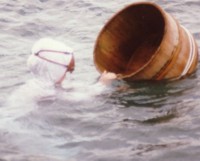Pearl
|
|
For other things called "pearl", see pearl (disambiguation).
A pearl is a hard, rounded object produced by certain mollusks, primarily oysters. Pearl is valued as a gemstone and is cultivated or harvested for jewellery.Pearls are formed inside the shell of certain bivalve mollusks. As a response to an irritating object inside its shell, the mollusk will deposit layers of calcium carbonate (CaCO3) in the form of the minerals aragonite or calcite (both crystalline forms of calcium carbonate) held together by an organic horn-like compound called conchiolin. This combination of calcium carbonate and conchiolin is called nacre.
The unique luster of pearls depends upon the reflection and refraction of light from the translucent layers and is finer in proportion as the layers become thinner and more numerous. The iridescence that some pearls display is caused by the overlapping of successive layers, which breaks up light falling on the surface. Pearls are usually white, sometimes with a creamy or pinkish tinge, but may be tinted with yellow, green, blue, brown, or black. Black pearls are often highly valued because of their rarity.
Pearl.jpg
Before the beginning of the 20th Century, pearl hunting was the most common way of harvesting pearls. Divers manually pulled oysters from ocean floors and river bottoms and checked them individually for pearls. Now, however, almost all pearls used for jewellery are cultured by planting a core or nucleus into Pearl Oysters. The pearls are usually harvested two years after the planting. This mariculture process was first developed by Kokichi Mikimoto from Japan, who was granted a patent for the process in 1896. The nucleus is generally a polished bead made from mussel shell. Along with a small scrap of mantle tissue from another oyster to serve as an irritant, it is surgically implanted near the oyster's genitals. Oysters which survive the subsequent surgery to remove the finished pearl are often implanted with a new, larger nucleus as part of the same procedure, and returned to the water for another two years of growth.
The original Japanese cultured pearls are produced by a species of small oysters no bigger than 6 to 7 mm in size, hence Japanese pearls larger than 10 mm in diameter are extremely rare and highly priced. In the past couple of decades, cultured pearls have been produced with larger oysters in the south Pacific and Indian Ocean. South Sea pearls are characterized by their large size and silvery color. Sizes up to 14 mm in diameter are not uncommon. Australia is one of the most important sources of South Sea pearls.
Recently (in the 1990s), the Japanese also invested in producing cultured pearls with freshwater mussels in the region of Shanghai, China, and Fiji. Freshwater pearls are characterized by the reflection of rainbow color in the luster. Cultured pearls are also being produced using abalone.
The value of the pearls in jewellery is determined by a combination of the luster, color, size, lack of surface flaw and symmetry that are appropriate for the type of pearl under consideration. Among those attributes, luster is the most important differentiator of pearl quality according to jewellers. All factors being equal, however, the larger the pearl the more valuable it is. Large perfectly round pearls are rare and highly valued. Teardrop-shaped pearls are often used in pendants. Irregular shaped pearls are often used in necklaces.
See also
- Baroque pearl
- Mother-of-pearl
- Broome
- Ammolite - another organic gemstone formed primarily of fossil aragonite mollusk shells.
External links
- http://www.geo.utexas.edu/courses/347k/redesign/gem_notes/pearl/pearl_main.htm
- Pearl Information Guide (http://www.pearl-guide.com)bg:Перла
da:Perle de:Perle es:Perla fr:Perle he:פנינה nl:Parel ja:真珠 pl:Perły pt:Pérola sl:biser zh:珍珠

